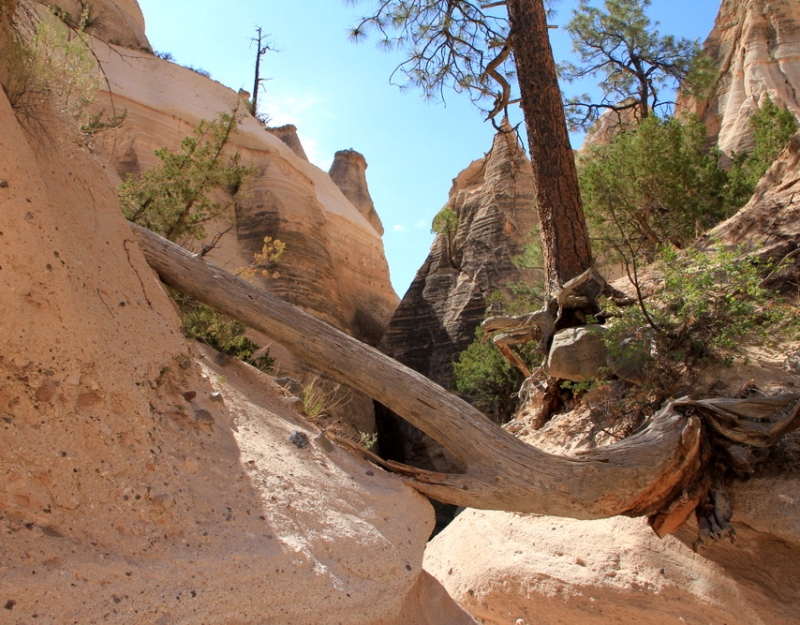Chambers Architects: Hiking In Kasha-Katuwe Tent Rocks National Monument
Above Photo: Stephanie M. Chambers
By Stephanie M. Chambers
In our Dallas architecture practice, we view the stewardship of nature as a sustainable act and an important part of our mission statement. In the design of Texas and Oklahoma homes and ranches, we endeavor to have as little impact on the environment as possible and the clients who choose to work with us are also committed to the preservation of their parcel of wilderness.
National wilderness preserves provided by the federal government belong to us all: the red rock canyons, turquoise rivers, redwood forests, desert plains, jagged mountains, Arctic tundra, wildflower fields, and cool forests. Wild spaces provide a great backyard for anyone who longs to participate in sustainability and view civilization from a completely different perspective. Nature’s beauty protects against the inclination to give up on society, despite relentless responsibilities and stress. Wilderness treks reaffirm a commitment to what our real treasures are and to the hope of peace on earth.
A few summers ago, we discovered Kasha-Katuwe National Monument, a profound wilderness adventure forty miles southwest of Santa Fe, near the historic pueblo of the Cochiti people. Its Keresan Pueblan name means, “white cliffs.” Tent Rocks was established as a U.S. National Monument in January 2001.
This monument in northern New Mexico is for foot travel only. It contains two segments that provide a remarkable outdoor laboratory, to observe, study, and experience the geologic processes that shape natural landscapes. It also provides opportunities for hiking, bird watching, and plant identification.
The cone-shaped tent rock formations called hoodoos are the products of volcanic eruptions that occurred six to seven million years ago and left pumice, ash, and tuff deposits over a thousand feet thick. Tremendous explosions from the Jemez volcanic field spewed pyroclasts (rock fragments), while searing hot gases blasted down slopes in an incandescent avalanche called a “pyroclastic flow.” Precariously perched on many of the tapered formations are boulder caps that protect the softer pumice and tuff below. Some tents have lost their hard, resistant caprocks, and are disintegrating. Fairly uniform in shape, the tent rock formations vary in height from a few feet up to ninety feet in the hot, dry desert. Minerals deposited within different rock types caused the hoodoos to have different color bands at varying heights.
Hearing only our labored breathing and footsteps, we climbed to the highest point, raised our camera and through the lens saw the daytime moon above the hoodoos. We marveled at the thoughtful act of a society that preserved this natural cathedral and allows us to be alone with something greater than our every day selves. This and other spectacular walks in the wilderness and through historical places are protected by our country through congressional legislation, or the president’s use of the Antiquities Act from 1906.
Why we need to designate wilderness sites as national monuments
1. Preserves our heritage. Protected wilderness is a uniquely American idea, and preserving lands allows us to imagine the wild country as our ancestors once experienced it.
2. Ensures public health. Each time we breathe air or drink water, we benefit from our wild places. The wilderness protects watersheds that provide drinking water to many cities and rural communities and helps improve the quality of our air.
3. Safeguards wildlife. The wilderness provides homes for a magnitude of species, some of which are disappearing from the planet through the loss of their habitats. In addition, wilderness provides migration routes and breeding grounds. More than half of the ecosystems in the United States exist within designated wilderness.
4. Adventure and a place to connect. People travel near and far to enjoy recreation experiences, increase health and wellbeing, seek a haven from the pressures of our fast-paced society, a relief from noise, haste, and crowds that confine us. It’s a place to enjoy with friends and families, strengthening our relationships and building lasting memories.
5. A natural laboratory for scientific understanding. Preserving ecological treasures allows us to witness and study entire ecosystems working in harmonious rhythm in a natural state. Without designated wilderness spaces, we would know very little about issues affecting the health and vibrancy of our wild lands, wildlife, and ourselves… and how to address and prevent catastrophic wildfires, invasive species, increased risk of disease, and changes in climate.
6. Good for the economy. Wilderness fuels local economies and provides jobs. The outdoor recreation economy has grown despite the recent recession, proving the lasting value of wild places. In Alaska, native populations rely on wilderness and the wildlife within it for subsistence and continuation of their cultural traditions.
7. A source of clean, renewable energy. Rich renewable energy resources found on federal wild lands, like wind and solar energy, play a key role in powering our future.
8. Celebrate our special wild places. Almost all Americans (81%) have been to a National Park and witnessed its grandeur with their own eyes. The memories last a lifetime, and the places deserve to be treasured.















